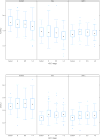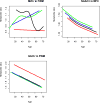Persistence of HIV-associated cognitive impairment, inflammation, and neuronal injury in era of highly active antiretroviral treatment
- PMID: 21297425
- PMCID: PMC4326227
- DOI: 10.1097/QAD.0b013e3283427da7
Persistence of HIV-associated cognitive impairment, inflammation, and neuronal injury in era of highly active antiretroviral treatment
Abstract
Objective: To determine whether cognitive impairment and brain injury as measured by proton magnetic resonance spectroscopy (MRS) persist in the setting of HAART.
Design: This study is an observational cohort study.
Methods: MRS was performed in 268 patients: HIV-negative controls (N = 28), HIV-positive neuroasymptomatic individuals (N = 124), and individuals with AIDS dementia complex (ADC; N = 50) on stable antiretroviral therapy (ART) with a mean duration of infection of 12 years and CD4 cell count of 309 cells/μl. Four metabolites were measured over creatine: N-acetyl aspartate (NAA), marker of neuronal integrity; choline (Cho), myoinositol, markers of inflammation, and glutamate and glutamine (Glx) in the basal ganglia, frontal white matter (FWM), and mid-frontal cortex. Analyses included analysis of variance, analysis of covariance, linear, and nonparametric regression models.
Results: Cognitive impairment was found in 48% of HIV-infected individuals. Both HIV-positive groups showed significant increases in myoinositol/creatine or Cho/creatine in all brain regions when compared to controls; a significant decrease in Glx/creatine in the FWM was observed in the neuroasymptomatic group; and only individuals with ADC showed a significant reduction in NAA/creatine, although a significant trend for decreasing NAA/creatine in the basal ganglia was found across the groups. Effects related to aging and duration of infection, but not central nervous system penetration effectiveness were observed.
Conclusion: Brain inflammatory changes remain ubiquitous among HIV-infected individuals, whereas neuronal injury occurs predominantly in those with cognitive impairment. Together these findings indicate that despite the widespread use of HAART, HIV-associated cognitive impairment and brain injury persist in the setting of chronic and stable disease.
Conflict of interest statement
Conflicts of Interest: None
Figures



Similar articles
-
A multicenter in vivo proton-MRS study of HIV-associated dementia and its relationship to age.Neuroimage. 2004 Dec;23(4):1336-47. doi: 10.1016/j.neuroimage.2004.07.067. Neuroimage. 2004. PMID: 15589098 Clinical Trial.
-
Progressive cerebral injury in the setting of chronic HIV infection and antiretroviral therapy.J Neurovirol. 2013 Jun;19(3):209-18. doi: 10.1007/s13365-013-0162-1. Epub 2013 Apr 24. J Neurovirol. 2013. PMID: 23613008 Free PMC article.
-
Plasma and Cerebrospinal Fluid Biomarkers Predict Cerebral Injury in HIV-Infected Individuals on Stable Combination Antiretroviral Therapy.J Acquir Immune Defic Syndr. 2015 May 1;69(1):29-35. doi: 10.1097/QAI.0000000000000532. J Acquir Immune Defic Syndr. 2015. PMID: 25622053 Free PMC article.
-
HIV-associated neurological disorders: a guide to pharmacotherapy.CNS Drugs. 2012 Feb 1;26(2):123-34. doi: 10.2165/11597770-000000000-00000. CNS Drugs. 2012. PMID: 22201342 Review.
-
Neurological disease: the effects of HIV and antiretroviral therapy and the implications for early antiretroviral therapy initiation.Curr Opin HIV AIDS. 2009 Sep;4(5):447-52. doi: 10.1097/COH.0b013e32832dd0c2. Curr Opin HIV AIDS. 2009. PMID: 20048710 Review.
Cited by
-
Assessing and treating forgetfulness and cognitive problems in adults with HIV.J Assoc Nurses AIDS Care. 2013 Jan-Feb;24(1 Suppl):S40-60. doi: 10.1016/j.jana.2012.03.006. J Assoc Nurses AIDS Care. 2013. PMID: 23290376 Free PMC article.
-
HIV, vascular and aging injuries in the brain of clinically stable HIV-infected adults: a (1)H MRS study.PLoS One. 2013 Apr 19;8(4):e61738. doi: 10.1371/journal.pone.0061738. Print 2013. PLoS One. 2013. PMID: 23620788 Free PMC article.
-
Monocyte maturation, HIV susceptibility, and transmigration across the blood brain barrier are critical in HIV neuropathogenesis.J Leukoc Biol. 2012 Mar;91(3):401-15. doi: 10.1189/jlb.0811394. Epub 2012 Jan 6. J Leukoc Biol. 2012. PMID: 22227964 Free PMC article. Review.
-
Effects of HIV and early life stress on amygdala morphometry and neurocognitive function.J Int Neuropsychol Soc. 2012 Jul;18(4):657-68. doi: 10.1017/S1355617712000434. Epub 2012 May 24. J Int Neuropsychol Soc. 2012. PMID: 22621973 Free PMC article.
-
Neurologic Complications in Treated HIV-1 Infection.Curr Neurol Neurosci Rep. 2016 Jul;16(7):62. doi: 10.1007/s11910-016-0666-1. Curr Neurol Neurosci Rep. 2016. PMID: 27170369 Review.
References
-
- Navia BA, Jordan BD, Price RW. The AIDS dementia complex: I. Clinical features. Ann Neurol. 1986;19(6):517–24. - PubMed
-
- Price RW, Brew BJ. The AIDS dementia complex. J Infect Dis. 1988;158(5):1079–83. - PubMed
-
- Palella FJ, Jr, Delaney KM, Moorman AC, Loveless MO, Fuhrer J, Satten GA, et al. Declining morbidity and mortality among patients with advanced human immunodeficiency virus infection. HIV Outpatient Study Investigators. N Engl J Med. 1998;338(13):853–60. - PubMed
-
- Ledergerber B, Egger M, Opravil M, Telenti A, Hirschel B, Battegay M, et al. Clinical progression and virological failure on highly active antiretroviral therapy in HIV-1 patients: a prospective cohort study. Swiss HIV Cohort Study. Lancet. 1999;353(9156):863–8. - PubMed
MeSH terms
Grants and funding
LinkOut - more resources
Full Text Sources
Other Literature Sources
Medical
Research Materials

